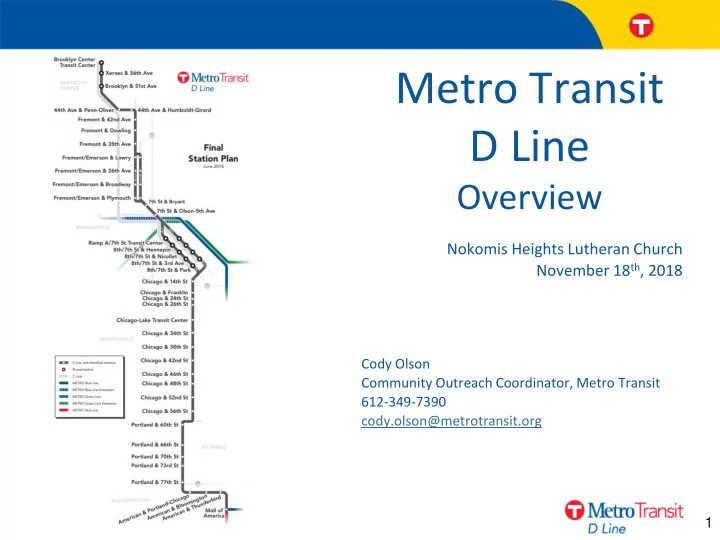

Metro Transit D Line Overview Nokomis Heights Lutheran Church November 18 th , 2018 Cody Olson Community Outreach Coordinator, Metro Transit 612-349-7390 cody.olson@metrotransit.org 1
Route 5: Existing Ridership • Highest ridership bus route • 15,000-17,000 weekday rides • Highest productivity (passengers/hour) local bus route • Ridership concentrated between Lake Street and Lowry Avenue • Buses make up 3-4% of vehicles, carry 25-35% of people 2
D Line Overview • Substantial replacement of Route 5, Metro Transit’s highest-ridership route • 2030 daily riders: 23,500 • D Line service every 10 minutes – Route 5 every 30 minutes • 20-25% faster than Route 5 – Fewer stops – Pre-boarding fare payment – All-door boarding – Transit signal priority • Construction in 2020/2021, pending full project funding Examples from A Line on Snelling Avenue in St. Paul 3
D Line Buses Route 5 (Today): Front-door boarding, all fares collected on board D Line: All-door boarding, all fares collected at station 4
D Line Buses • Increased ridership = less vehicle demand • Newer buses with fewer emissions – Battery-electric under consideration: currently being piloted on the C Line – Metropolitan Council developing electrification plan • Buses spend less time stopped, more time in motion C Line 60ft Articulated Buses to begin service in 2019 5
Chicago and 52nd • Approximately 35 boardings per weekday • Southbound: Relocation of the stop to far side • Northbound: Expansion of bus stop • Chicago and 54 th considered: driveways at ¾ corners 6
How it Works • Rapid bus runs in general traffic with stations built on curb bumpouts. These reduce delay for buses and provide space for station amenities and pedestrians. • Customers will pay fares at stations prior to boarding the bus. Off-board fare payment significantly decreases the time it takes to board, allowing buses to stop briefly in the travel lane rather than pull over. • Vehicles will stop behind the bus briefly while it stops. Buses only stop if a customer is waiting to get on or off, and most stops take about 10-15 seconds. • Traffic study has shown that D Line will not result in substantial impact to traffic at this location.
Arterial BRT Stations
Next Steps Final Plan Approved: July 25 th , 2018 Design work to begin in late 2018/Early 2019 9
Contact metrotransit.org/d-line-project Cody Olson Community Outreach Coordinator, Metro Transit 612-349-7390 cody.olson@metrotransit.org 10
Recommend
More recommend